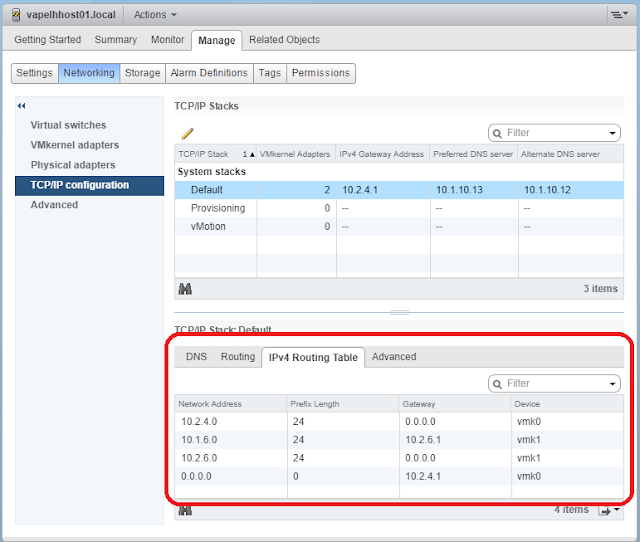- Storage appliance is on the 10.1.6.0/24 subnet.
- The new vmkernel interface is on the 10.2.6.0/24 subnet. In my lab 10.2.0.0/16 is meant to represent a remote site.
- All VLANs and subnets are defined on a single Cisco router/switch which means that all routes are directly connected.
Configuration of vmkernel interfaces. This does not change (long lines wrapped). iSCSI is defined on vmk1.
[root@VAPELHhost01:/] esxcfg-vmknic --list
Interface Port Group/DVPort/Opaque Network IP Family IP Address Netmask Broadcast MAC Address MTU TSO MSS Enabled Type NetStack
vmk0 Management Network IPv4 10.2.4.10 255.255.255.0 10.2.4.255 2c:59:e5:39:fb:14 1500 65535 true STATIC defaultTcpipStack
vmk1 0206-iSCSI IPv4 10.2.6.10 255.255.255.0 10.2.6.255 00:50:56:62:37:5d 1500 65535 true STATIC defaultTcpipStack
[root@VAPELHhost01:/]
Routing table before fix:
[root@VAPELHhost01:~] esxcfg-route --list
VMkernel Routes:
Network Netmask Gateway Interface
10.2.4.0 255.255.255.0 Local Subnet vmk0
10.2.6.0 255.255.255.0 Local Subnet vmk1
default 0.0.0.0 10.2.4.1 vmk0
My first attempt to fix the problem failed as I used the IP address of the iSCSI vmkernel interface as the destination.
Add (incorrect) static route using vmkernel interface as destination.
[root@VAPELHhost01:~] esxcfg-route --add 10.1.6.0/24 10.2.6.10
Adding static route 10.1.6.0/24 to VMkernel
New (incorrect) routing table. Interface vmk1 has a new route.
[root@VAPELHhost01:~] esxcfg-route --list
VMkernel Routes:
Network Netmask Gateway Interface
10.1.6.0 255.255.255.0 10.2.6.10 vmk1
10.2.4.0 255.255.255.0 Local Subnet vmk0
10.2.6.0 255.255.255.0 Local Subnet vmk1
default 0.0.0.0 10.2.4.1 vmk0
New (incorrect) route fails.
[root@VAPELHhost01:~] esxcli network diag ping --host=TOPOLHNAS01is.local --interface=vmk1
Summary:
Duplicated: 0
Host Addr: TOPOLHNAS01is.local
Packet Lost: 100
Recieved: 0
Roundtrip Avg MS: -2147483648
Roundtrip Max MS: 0
Roundtrip Min MS: 999999000
Transmitted: 3
Trace:
[root@VAPELHhost01:~] esxcli network diag ping --host=TOPOLHNAS01is.local
Summary:
Duplicated: 0
Host Addr: TOPOLHNAS01is.local
Packet Lost: 100
Recieved: 0
Roundtrip Avg MS: -2147483648
Roundtrip Max MS: 0
Roundtrip Min MS: 999999000
Transmitted: 3
Trace:
[root@VAPELHhost01:~]
I realize my mistake and try again, this time using the IP address of the default gateway for the local iSCSI subnet.
Remove incorrect static route.
[root@VAPELHhost01:~] esxcfg-route --del 10.1.6.0/24 10.2.6.10
Deleting static route 10.1.6.0/24 from VMkernel
Add correct route, use default gateway of the local iSCSI subnet.
[root@VAPELHhost01:~] esxcfg-route --add 10.1.6.0/24 10.2.6.1
Adding static route 10.1.6.0/24 to VMkernel
Test new (corrected) static route. Success.
[root@VAPELHhost01:~] esxcli network diag ping --host=TOPOLHNAS01is.local --interface=vmk1
Summary:
Duplicated: 0
Host Addr: TOPOLHNAS01is.local
Packet Lost: 0
Recieved: 3
Roundtrip Avg MS: 524
Roundtrip Max MS: 1036
Roundtrip Min MS: 268
Transmitted: 3
Trace:
Detail:
Dup: false
Host: 10.1.6.10
ICMPSeq: 0
Received Bytes: 64
Roundtrip Time MS: 1037
TTL: 63
Detail:
Dup: false
Host: 10.1.6.10
ICMPSeq: 1
Received Bytes: 64
Roundtrip Time MS: 268
TTL: 63
Detail:
Dup: false
Host: 10.1.6.10
ICMPSeq: 2
Received Bytes: 64
Roundtrip Time MS: 268
TTL: 63
[root@VAPELHhost01:/] esxcli network diag ping --host=TOPOLHNAS01is.local
Summary:
Duplicated: 0
Host Addr: TOPOLHNAS01is.local
Packet Lost: 0
Recieved: 3
Roundtrip Avg MS: 2606
Roundtrip Max MS: 7304
Roundtrip Min MS: 241
Transmitted: 3
Trace:
Detail:
Dup: false
Host: 10.1.6.10
ICMPSeq: 0
Received Bytes: 64
Roundtrip Time MS: 7305
TTL: 63
Detail:
Dup: false
Host: 10.1.6.10
ICMPSeq: 1
Received Bytes: 64
Roundtrip Time MS: 274
TTL: 63
Detail:
Dup: false
Host: 10.1.6.10
ICMPSeq: 2
Received Bytes: 64
Roundtrip Time MS: 242
TTL: 63
[root@VAPELHhost01:/]
New routing table. Interface vmk1 points to default gateway of remote iSCSI subnet, i.e. 10.2.6.1.
[root@VAPELHhost01:/tmp/iscsi2] esxcfg-route --list
VMkernel Routes:
Network Netmask Gateway Interface
10.1.6.0 255.255.255.0 10.2.6.1 vmk1
10.2.4.0 255.255.255.0 Local Subnet vmk0
10.2.6.0 255.255.255.0 Local Subnet vmk1
default 0.0.0.0 10.2.4.1 vmk0
[root@VAPELHhost01:/tmp/iscsi2]
The final step is to inform vCenter of the changes:
[root@VAPELHhost01:~] /etc/init.d/hostd restart
watchdog-hostd: Terminating watchdog process with PID 109254
hostd stopped.
Ramdisk 'hostd' with estimated size of 803MB already exists
hostd started.
[root@VAPELHhost01:~] /etc/init.d/vpxa restart
watchdog-vpxa: Terminating watchdog process with PID 109940
vpxa stopped.
[root@VAPELHhost01:~]
Then refresh Web Client.
Version of ESXi.
[root@VAPELHhost01:~] vmware -v
VMware ESXi 6.0.0 build-5050593
[root@VAPELHhost01:~]
Done.
References:
